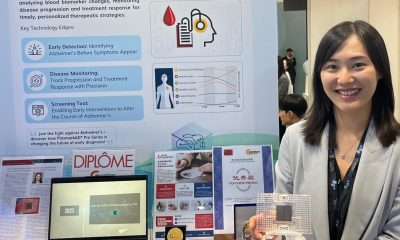Insights
Half of Brits fear dementia more than any other condition, research finds

Half of UK adults fear dementia more than any other health condition, with women and over-65s the most likely to share this concern, new research shows.
The figures come from the latest Dementia Attitudes Monitor, a biennial survey of more than 2,000 people that tracks how the public thinks and feels about dementia.
It explores what people believe raises their risk, how likely they are to seek a diagnosis, and their views on how effective treatments are.
Now in its fourth wave since launching in 2018, the survey was commissioned by Alzheimer’s Research UK and shows that fear remains high as dementia continues to be the UK’s leading cause of death.
Hilary Evans-Newton is chief executive of Alzheimer’s Research UK.
She said: “People fear dementia because there is still no cure. Dementia continues to rob people of their independence and place an immense strain on families and society.
“By 2040, 1.4 million people in the UK are expected to be living with dementia, making progress more urgent than ever.”
While 59 per cent of UK adults say they would feel comfortable discussing a diagnosis, stigma remains a major barrier, particularly among minority ethnic communities.
Among Black African, Black Caribbean and Black British adults, this drops to 46 per cent, with more than a third (35 per cent) saying they would not feel comfortable — compared with 23 per cent of white respondents.
Views also vary by age.
Nine in ten people aged 35–64 said they would likely seek a diagnosis if they were worried about early-stage Alzheimer’s or another form of dementia.
Among adults aged 65 and over, this falls slightly to eight in ten.
Older adults are twice as likely to say they wouldn’t seek a diagnosis: seven per cent of those aged 35–64 said they probably wouldn’t speak to a doctor, compared with 14 per cent of people aged 65 and over.
Alzheimer’s Research UK is tackling stigma through its Dementia Community Champions programme, which supports volunteers to start conversations about dementia, stigma and research within their own communities.
Emily Allen, a supporter of the charity whose mother was diagnosed with young-onset Alzheimer’s in 2010, shared her experience.
She said: “When mum was first diagnosed, I didn’t know much about dementia.
“I remember searching the internet for any information I could find about Alzheimer’s.
“I couldn’t comprehend the thought of mum not knowing my name, not knowing who I am. It was terrifying.
“When I discussed it with my sisters, we would call it the ‘Big A’ as we couldn’t bring ourselves to say the word.
“I think there is more understanding among the public about dementia now.
“But there is still so much fear because of how it affects people and their families, and because there are so few effective treatments available.”
When asked to choose the top priorities for dementia research from a list of eight, 43 per cent of respondents selected finding a cure as the most or second-most important goal, followed closely by prevention.
Since the previous wave of the monitor in 2023, two new treatments — lecanemab and donanemab — have been licensed in the UK (2024).
Although not yet available on the NHS, they mark a significant milestone in research and may explain why the public continues to prioritise a cure.
Insights
Weight loss jabs could make cancer scans less effective, study suggests

Weight loss jabs such as Mounjaro and Wegovy could make some cancer scans less effective, leading to unnecessary tests and possible delays in treatment, experts suggest.
The drugs, collectively known as GLP-1s, have helped millions lose up to a fifth of their body weight but may alter how tissue appears on PET-CT scans used to diagnose and stage cancers.
The changes could cause healthy tissue to be misinterpreted as potentially cancerous, meaning some patients may face extra investigations and anxiety while awaiting results.
British researchers at Alliance Medical, a leading provider of diagnostic imaging in the UK, identified the issue after noticing unusual patterns in patient scans.
PET-CT scans combine CT and PET imaging, using a mildly radioactive liquid called a tracer to highlight areas where cells are more active than normal. Brighter spots can indicate cancer, though they may also reflect infections or inflammation.
“We noticed unusual uptake in one of our patients on a GLP-1 agonist, which prompted a wider review across our network,” said Dr Peter Strouhal, medical director at Alliance Medical and lead author of the study.
“We found that these altered patterns are increasingly common, yet there is currently no national or international guidance in the UK addressing this emerging issue.”
The review of several PET-CT scans found atypical tracer patterns among GLP-1 users that “could be misinterpreted” as hot spots or potentially cancerous areas.
“Recognising the characteristic uptake associated with GLP-1 agonists helps avoid unnecessary anxiety and interventions, ensuring patients receive the right care, at the right time, without detours or doubt,” Dr Strouhal said.
Researchers said larger studies involving more data are needed before recommendations can be made to change PET-CT scan guidelines for weight loss jab users.
They advised clinicians to consider a patient’s medical history when interpreting results.
It follows earlier US research suggesting GLP-1 drugs could interfere with breast-cancer chemotherapy medicines.
That study tracked hundreds of women with early-stage triple-negative breast cancer during and after treatment.
Twenty-five were already taking GLP-1s alongside other diabetes drugs and continued doing so while undergoing chemotherapy.
Two years later, 28 per cent of the women on GLP-1s had fully responded to treatment and were clear of cancer, compared with 63 per cent of those not using the drugs.
Researchers also found GLP-1s had entered tumour and immune cells in tissue samples from the patients.
“Use of GLP-1 use may need to be carefully considered during breast cancer therapy,” said Dr Bethania Santos, oncologist and researcher at UT Southwestern Medical Center in Dallas, who presented the study at the San Antonio Breast Cancer Symposium.
However, experts at the time said the drugs themselves may not have reduced the effectiveness of chemotherapy.
People with advanced diabetes who require several medicines already have a higher risk of breast-cancer recurrence.
The study did not prove whether weight-loss drugs help or hinder the success of cancer therapy.
News
New technique can track Alzheimer’s in real time

Scientists have developed an innovative technique to observe Alzheimer’s disease as it progresses in the brain – a breakthrough that could accelerate the development of new treatments.
The new method uses light to detect and measure the build-up of amyloid plaques – sticky protein clumps that are a key characteristic of Alzheimer’s – at different depths in the brain.
It is the first time such measurements have been made in living animals as they move naturally, rather than under anaesthetic or in fixed positions.
The research was carried out by the University of Strathclyde in partnership with the Istituto Italiano di Tecnologia, the University of Padua and the Technical University of Denmark, combining expertise in neuroscience, physics and biomedical imaging.
Professor Shuzo Sakata at Strathclyde and senior author of the study said: “Being able to monitor changes in the brain as they happen – in real time and across different brain regions – is a major step forward.
“It will help researchers understand how Alzheimer’s disease develops and test whether new treatments are working, more quickly and accurately than before.”
A special fluorescent dye that attaches to amyloid plaques in the brain was used.
Ultra-thin optical fibres were then applied to shine light into the brain and measure how much of the dye was present – providing a clear picture of how much plaque had formed.
The system was tested in mice that had been genetically modified to develop Alzheimer’s-like symptoms. The results closely matched those seen in postmortem brain tissue, confirming the accuracy of the new technique.
The research was funded by the European Union’s Horizon 2020, the Medical Research Council, part of UKRI, and Alzheimer’s Research UK.
“This approach allows us to track the disease over time in the same subject, and opens new doors for studying the progression of Alzheimer’s and how it responds to treatment,” said Dr Niall McAlinden, co-author and expert in photonics at Strathclyde.
The team is now working to improve the system’s capabilities and explore its use in studying other characteristics of Alzheimer’s disease.
Wellness
Microplastics could increase bowel cancer and depression risk

Microplastics from food packaging may damage the gut and raise the risk of bowel cancer and depression, new research suggests.
Austrian researchers made the discovery after examining stool tissue from healthy volunteers and found that the tiny particles could alter microbial activity in the gut, with some of the changes reflecting patterns previously linked with depression and bowel cancer.
Experts described the findings as “significant” and said it was the first human study to show that these plastic fragments could alter the human gut microbiome – the community of microorganisms that live in the digestive system.
Researchers from the University of Graz used stool samples from five healthy volunteers to grow gut microbiome cultures, which were then exposed to five common microplastic types – polystyrene, polypropylene, low-density polyethylene, poly(methyl methacrylate) and polyethylene terephthalate.
All samples were tested at concentrations reflecting estimated human exposure, as well as higher doses to explore possible dose-dependent effects.
Microplastics are plastic fragments as small as two micrometres – around two-thousandths of a millimetre – which enter food, water supplies and even the air as plastics degrade naturally.
Recent studies have identified microplastics in human lung tissue, maternal and foetal placental tissue, human breast milk and human blood. A growing body of research has also linked them to cancer, heart disease, dementia and lower-quality sperm.
“These findings are significant given how pervasive microplastic exposure is in everyday life,” said Christian Pacher-Deutsch, a microplastics researcher at the University of Graz and lead author of the study.
“Microplastics have been found in fish, salt, bottled water, and even tap water, meaning that most people are exposed daily through ingestion, inhalation and skin contact.
“The key takeaway is that microplastics do have an impact on our microbiome.
While it’s too early to make definitive health claims, the microbiome plays a central role in many aspects of well-being, from digestion to mental health.
“Reducing microplastic exposure where possible is therefore a wise and important precaution.”
Although total bacterial cell counts remained largely unchanged, microplastic-treated samples showed a consistent and significant increase in acidity compared with untreated ones, indicating altered microbial activity.
Further analysis showed that certain bacterial groups changed in composition depending on the microplastic type, with most changes occurring within the phylum Bacillota – a key group of gut bacteria important for digestion and overall gut health.
The researchers also discovered that some of these microplastic-related changes mirrored microbial patterns previously linked to diseases such as depression and bowel cancer.
Scientists said they were not yet certain why this occurred but suggested several possible explanations.
“For instance, biofilms can form on microplastic surfaces, providing new niches that some microbes colonise more rapidly,” said Mr Pacher-Deutsch.
“Microplastics may also carry chemical substances that directly influence bacterial metabolism.
“This can lead to changes in acid production, which may serve as a bacterial stress response, unintentionally altering the gut’s pH.”
The research will be presented in full at the United European Gastroenterology annual congress in Berlin on 7 October.
There are around 44,000 cases of bowel cancer every year in the UK and 142,000 in the US, making it the fourth most common cancer in both countries.
Symptoms often include changes in bowel movements such as persistent diarrhoea or constipation, feeling the need to poo more or less frequently and blood in the stool. Stomach pain, bloating, a lump in the abdomen, fatigue and unexplained weight loss are among other signs.
Although the vast majority of bowel cancer diagnoses affect those aged over 50, rates in younger adults have risen by about 50 per cent over the past 30 years, while figures in older age groups have remained stable or declined.
Cancer Research UK estimates that over half (54 per cent) of bowel cancer cases in the UK are preventable.

 News1 month ago
News1 month agoHep B vaccine may lower diabetes risk, study suggests

 News2 weeks ago
News2 weeks agoSimple test can predict risk of severe liver disease

 Insights2 months ago
Insights2 months agoInterview: How AI-driven blood test could speed Alzheimer’s diagnosis

 News1 month ago
News1 month agoOdds of dementia strongly linked to number of co-existing mental illnesses, study finds

 Insights4 days ago
Insights4 days agoWeight loss jabs could make cancer scans less effective, study suggests

 Research2 months ago
Research2 months agoLong Covid causes effects similar to Parkinson’s or stroke, research reveals

 Wellness3 weeks ago
Wellness3 weeks agoExercise may lower dementia risk, study suggests

 News1 month ago
News1 month agoSweeteners could age the brain by 1.6 years, research suggests
































